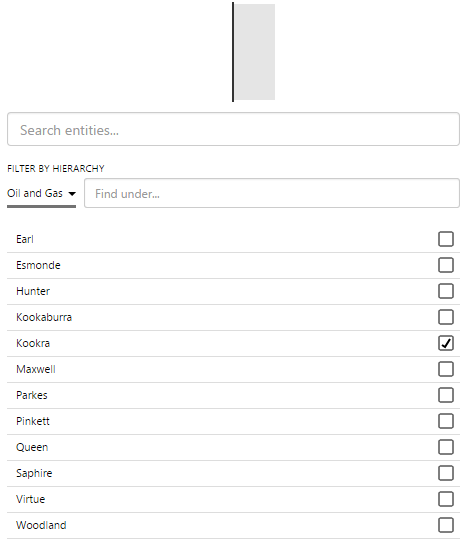Overview
The Target Variance Bar shows a variance value from a target as a bar. By default, the bar is red when the variance is below the target, or grey when the variance is at or above the target.
The following diagram shows a Target Variance Bar being configured:
| Source Data: | The dataset from which the values are obtained. |
| Actual Column: | The column from the dataset that determines the actual value used for calculating the variance from a target. |
| Target Column: | The column from the dataset that determines the value used for calculating the variance from this target. |
| Max Variance Column: | The column from the source data that determines the maximum variance value. This determines the proportion of the bar that is filled. It is commonly used to align multiple Target Variance Bars to the same scale so that comparisons can be made easier.
For example, if you had 3 Target Variance Bars in a table, with max variances of 20, 40, and 60, you would set the max variance for all of them to 60. |
| Filter Column: | The column of the dataset that provides the values that will be assessed. This is used in conjunction with the Filter Value. |
| Filter Value: | The row of the dataset that provides the values that will be assessed. |
| Colours: | The number of colours specified should be the number of Thresholds + 1. The order in which the colours are specified should be the same order that the thresholds are specified. |
| Thresholds: | The values at which the bar colour should change. The highest threshold value should be less than the value of Max Variance.
By default, the thresholds are set to 60% under, 30% under, and 0%. So if the actual value is more than 60% under target, the colour of the bar is deep red. At 0% (i.e. the target has been met), the colour changes to grey. |
| Reverse Colours: | Select this check box to invert the colour thresholds. |
Tutorial
The Target Variance Bar is a useful component to display variances of production from target. In this topic, we’ll show you how to use the Target Variance Bar to display the variance from planned water production for a selected well. This is often used in production summary reports.
Let’s look at how we’re actually going to do this, step-by-step.
Step by Step: Creating a Target Variance Bar
Before you start, open a new tab in Explorer and click the “Create a New Page in Studio Mode” thumbnail. Choose the grid layout – you can adjust the rows and columns if you like but it’s not important for this exercise.
You will need to adjust the configuration to suit your data at your site.
Step 1. Add the source data
Before we can display any data on the page, we need to add the source data.
- Below the canvas, click the button labelled “Add Data“.
- Choose the data you are going to use. For this tutorial, we are using a dataset called “WelPlanningData”.
- In the configuration options, specify the following:
- Name: WelPlanningData1 (this is automatically added)
- Query: WelPlanningData (this is the query in P2 Server that is being used to return the data)
- StartDate: (Datetime) 01/04/2015 12:00:00 AM
- EndDate: (Datetime) 30/04/2015 12:00:00 AM
- EntitiesList: (Event) selectedEntity
Step 2. Add the Target Variance Bar
Drag and drop the Target Variance Bar component onto a grid cell.
Step 3. Configure the Target Variance Bar
Configure the Target Variance Bar as follows:
- Source Data: WelPlanningData1
- Actual Column: (Text) WaterActual
- Target Column: (Text) WaterPlanned
- Max Variance Column: (Text) WaterVariance
- Reverse Colours: (Yes/No) (select this check box)
Step 4. Add the Entity Selector
This step allows the user to select an entity, which will drive the Target Variance Bar.
- Drag and drop the Entity Selector control onto the canvas.
- Configure it as follows:
- Selected Entity: selectedEntity
- Selected Entities: (blank)
- Hierarchy Name: (Text) Oil and Gas
- Template Filter: (Text) Oil Producing Well
- Number of Selections: 1
Step 5. All done!
Congratulations! You now have a Target Variance Bar that will show you the variance from planned water production for a selected well.
- Click the preview
 button on the Studio toolbar to see what your page will look like in run-time.
button on the Studio toolbar to see what your page will look like in run-time. - Select entities and observe the changes in the target variance bar.
![]() Don’t forget to save your page!
Don’t forget to save your page!





